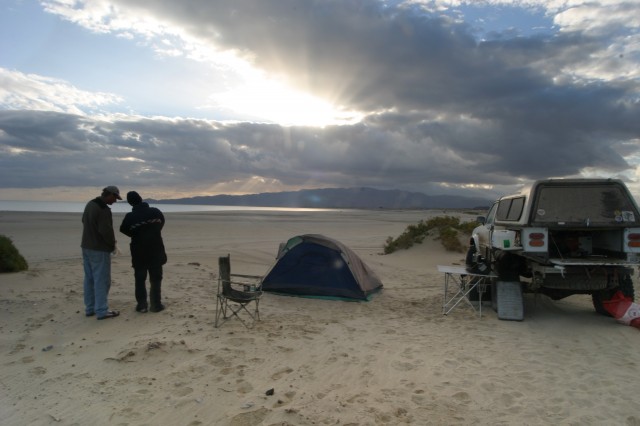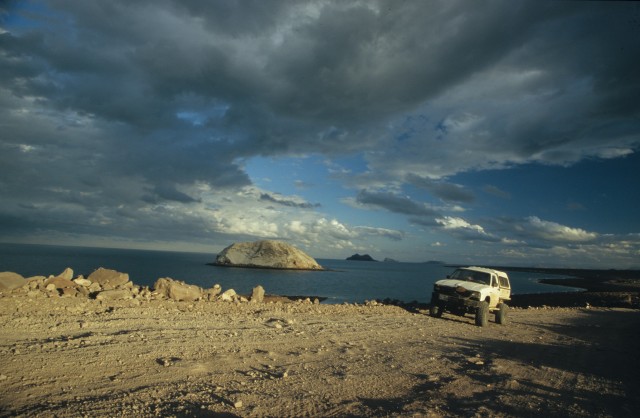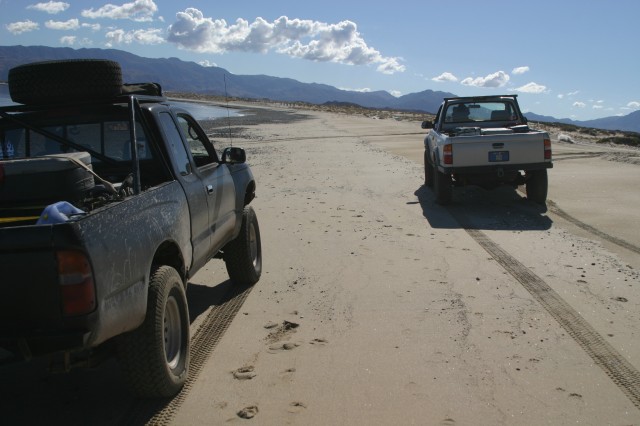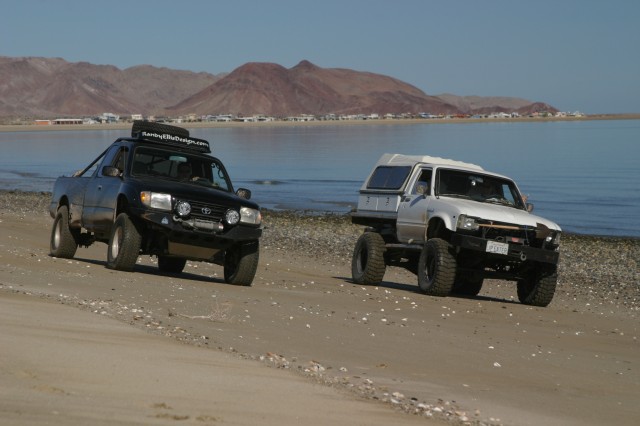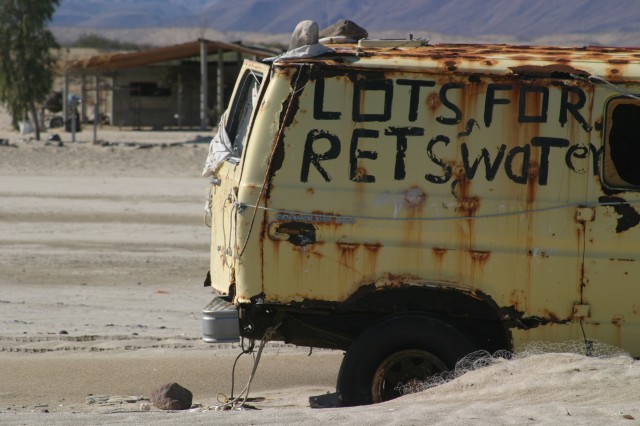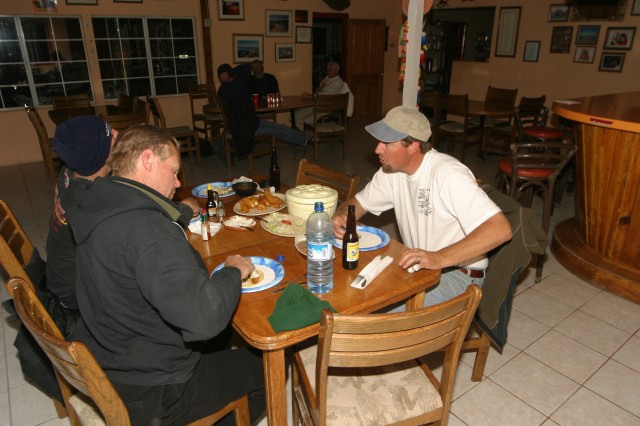I was crawling out from underneath my Toyota pickup, hands and forearms slathered in 90-weight oil and brake shoe dust when the phone rang. It was my friend Ned Bacon. Before I go any further I need to say that Ned is the kind of guy who likes to have a good time. He is also the type you can count on when you are in a bind. He might not take my place in a Tijuana jail cell, but he would at least get my truck safely back across the border, and might even cough up the denero to bail me out. Several years ago, he and another friend, Randy Ellis, towed me across 90 miles of Baja California desert on the end of a strap; then torched the midnight oil helping me replace a cracked head on my old `82 Toyota Hilux. In short, they are good guys to travel with. I raised the receiver to my ear a voice said, “Want to go to Baja for the 1000?” It took all of a millisecond for my frontal lobe to process the thought and send an electronic impulse to my lips and tongue. “I’m in!” I responded.
Six months later I pulled into the 4Wheel Parts store in Sacramento for a new set of Pro Comp X-Terrain tires. I had accepted an assignment from Off Road Adventures to cover the 1000, and Pro Comp had ponied up a new set of dogs for the sole purpose of me taking them south for a 10-day south-of-the-border bashing. I’m a strong proponent of real-life testing of anything that is intended to handle real-life situations. However, I negated to tell them I was going to put these tires through a lifetime of abuse in less than two weeks. I also didn’t tell them that I’ve never returned from Baja without at least a couple of plugged or punctured tires—often shredded open by a comi-cactus like a pack of hot dogs at a Yankees game.
Baja California is referred to as Mexico’s frontier state. The fact that it has only one paved road leading from Tijuana, at the US border, to Cabo San Lucas 900 miles to the south, should tell you something. But this was going to be dirt, dirt, and more dirt; a fast, mad dash through the most desolate reaches of Baja’s badlands. It would be an exercise in speed, dust, cacti, Corona, and 24/7 adrenalin. And that would just be getting to the race.
SCORE, Border Towns and 40 Hours of Driving.
The Baja 1000 is the quintessential embodiment of everything off-road. It is the ultimate trial of human will and endurance, and this year’s race would test the mental, physical, and mechanical preparedness of more than 290 teams. Some years the course is a loop to-and-from Ensenada and less than 1,000 miles long. This year, however, it would all the way to the tip, to Cabo San Lucas 1013 miles to the south and would follow some of the original lines from the inaugural Baja 1000 in 1967.
I wasn’t networked with the “in” crowd enough to hitch a ride with one of the race teams, schmooze the inside scoop on pit row, or merit a satellite uplink for daily progress reports. And catching a money shot while hiked out the side of a helicopter was about as likely as finding a dream bride in a border town brothel.
The plan was to renegade the event. We’d simply bust on down the peninsula, jump on the course heading south, and cut’em off at the pass. Press pass? We don’t need no stinking press pass. I figured we probably knew every back-road and two-track from the border to La Paz, and many that were not on the map. I had downloaded the course map online and knew most of the route: Ensenada over the mountains to San Felipe, south to Coco’s Corner, through Calamajué Canyon and over to Bahia de Los Angeles—got it, no problema.
My navigator, Rich Currie, and I rolled out of Sacramento at 9:00 p.m. for a red-eye haul to the border where we’d meet Ned and Randy in Calexico. Visions of a mechanically challenged future seared the recesses of my mind when both my windows came off their tracks before the first turn from my house. Then, at about 1:00 a.m., while driving down Interstate 5 at 70 mph, the headlights went out. A dark omen? Nope, any trip to Baja mandates expecting the unexpected. Luckily, a tailgating semi illuminated my path to the side of the road. The culprit was a loose fusible link connection at the battery, another quick fix.
Mile 000: The sun blazed intensely through the windshield as we hit the border and found Ned and Randy. Mexicali, on the south side of the international line, is a typical border town complete with funky intersections, stop lights you can’t see, loco taxi drivers, street peddlers, and kids at every stop sign offering to wash your windows with dirty rags and muddy water. It’s not the type of place you’d want your daughter to be walking about alone at night. The chaos faded in our rearview mirrors as we disappeared into the mirage of Laguna Salada, a seemingly endless alluvial plane at the terminus of the Colorado River. I’d been awake for 20 hours by the time we hit our favorite taco stand in San Felipe, and we wouldn’t unroll our sleeping bags until we made it to Bahia San Luis Gonzaga, another four hours to the south.
San Felipe, Beach Running, and Federale Checkpoints
Discovered in the late 1700s and geographically isolated by land and sea, the remote fishing village of San Felipe was almost completely cut off from the Western world until the installation of a U.S. radar facility during World War II. Today, the sleepy seaside town plays host to dozens of races and is a mecca for sun-worshiping co-eds from the States. Its old world charm resides in the dusty cantinas, authentic restaurants, and taco stands that line the malecón. San Felipe is also the last place to stock up on necessities: fuel, fresh tortillas, tequila, and cerveza fria.
Mile 135: Though there is road heading south to Puertecitos, a chuck-holed, chip-sealed affair, we were done with the pavement and were ready for Baja’s beaches and dirt two-tracks. Slipping down to the playa south of town, we followed the lonely coastline along endless sand beaches, broken only by an occasional volcanic outcroppings and rows of palapas and small beach homes. It was dark by the time we passed Speedy’s Camp and the decaying Pemex station near Puertecitos. The squawking of gulls is the noisiest thing you will hear in this tranquil collection of eclectic abodes. The gas station has been boarded up for years and a small cantina opens only when the owner feels like working. The major attraction to Puertecitos, besides the dead silence, is a small geothermal hot tub on the water’s edge.
Mile 175: South from Puertecitos the rocky graded two-track ascends the coastal foothills. Ocotillo and desert sage dot the seemingly lifeless landscape and evidence of civilization becomes increasingly sparse. Illuminated only by the headlights, the next 40 miles were a blur as we rallied at speed through rock-strewn arroyos and alluvial washes—our vices for cognitive consciousness had turned from coffee and Mt. Dew to Pacifico and cheap Mexican cigarettes. Five miles from Gonzaga a waving dim light summoned us to a stop; a military checkpoint.
We were greeted by two 18-year-old federales with guns standing by an OD green Hummer. Reverting back to our high school days, we slipped our sodas behind the seat (like it would matter) and informed the fine young gun-toting boys we were very important photographers (not quite a half-truth) and it was important that we not be delayed. It is a good thing that everyone in Baja knows about and loves the races. We slipped them a soda and one of those magazines your dad kept hidden, and were off.
Fish Tacos, Baja Sunrises, and…Bud Light?
Alfonsina’s, which was established in the 1950s, sits at the north end of Gonzaga Bay and is a must-stop for the Baja traveler. Though the original stone-and-mortar cantina has been expanded and modern rooms have replaced the rustic single-cot stone abodes, it has managed to retain its old-world charm. The view of Gonzaga Bay from the veranda is spectacular, and a great place to relax with a coldy and take in the local flavor. They were shutting down for the night, but Randy sweet-talked them into keeping the lights on and we proceeded to inhale some of the best tacos de pescado on the peninsula. A light breeze blew across a deserted beach and the clapping of small waves slapping against the sand was the only disruption to a calm and moonless night. Sleep final arrived about 10:00 p.m.
The Baja desert came alive as the sun crested the Sea of Cortez, casting radiant hues of yellow, orange, and magenta across the rugged Sierra San Pedro Martir Mountains. I was pouring my second cup of coffee when I noticed Randy popping open his second Bud Light, cracking a wicked grin as he inverted the can against his lips. For the record, bringing beer to Baja is just plain wrong, sacrilegious, and immoral. And Bud Light? Baja is all about cold Corona, Dos Equis, Pacifico, and fine añejo. Still in his sleeping bag, he sat there drinking and grinning….but that’s just Randy. Packing up early, we hit the playa, and blasted south, three vehicles abreast in search of the next two-track; we might even find a race if we didn’t run out of beer.
Stay tuned for part two of Got Baja?



